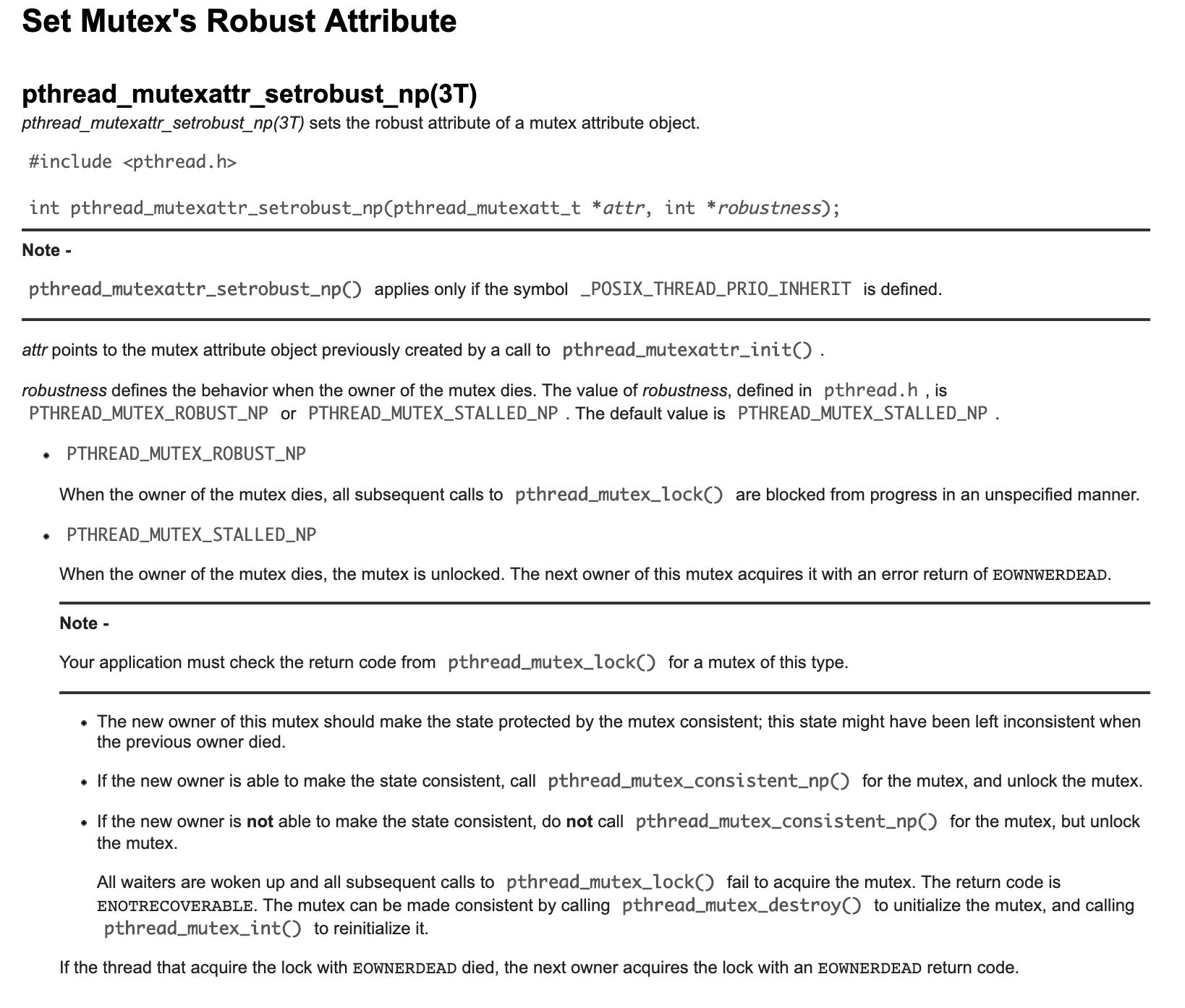互斥锁的robust属性的介绍和使用
一个具体的场景:在多线程中,当一个线程获得锁之后异常退出后,应该怎么处理?
方案一 使用锁的robust特性

简单地讲,就是当拥有这个锁的线程挂了后,下一个尝试去获得锁的线程会得到EOWNWERDEAD的返回值,新的拥有者应该再去调用pthread_mutex_consistent_np()来保持锁状态的一致性,并解锁。
直接上代码看示例:
/*================================================================
* Copyright (C) 2019 Ltd. All rights reserved.
*
* File Name :robust_mutex.c
* Author :Hamilton
* Date :2019-07-30
* Descriptor:
*
================================================================*/ #include <stdlib.h>
#include <stdio.h>
#include <unistd.h>
#include <pthread.h>
#include <errno.h> #define handle_error_en(en, msg) \
do { errno = en; perror(msg); exit(EXIT_FAILURE); } while () static pthread_mutex_t mtx; static void *original_owner_thread(void *ptr)
{
printf("\n[original owner] Setting lock...\n");
pthread_mutex_lock(&mtx);
printf("[original owner] Locked. Now exiting without unlocking.\n");
pthread_exit(NULL);
}
static void *bad_thread(void *ptr)
{
printf("\n[bad owner] Setting lock...\n");
pthread_mutex_lock(&mtx);
printf("[bad owner] Locked. Now exiting without unlocking.\n");
pthread_exit(NULL);
}
static void *second_thread(void *ptr)
{
int i = ; while (i--)
{
int s = pthread_mutex_lock(&mtx); if (s == EOWNERDEAD)
{
printf("\n[second thread] pthread_mutex_lock() returned EOWNERDEAD\n"); printf("[second thread] Now make the mutex consistent\n");
s = pthread_mutex_consistent(&mtx);
if (s != )
handle_error_en(s, "pthread_mutex_consistent"); printf("[second thread] Mutex is now consistent; unlocking\n");
s = pthread_mutex_unlock(&mtx);
if (s != )
handle_error_en(s, "pthread_mutex_unlock"); }
else if (s < )
{
printf("\n[second thread] pthread_mutex_lock() unexpectedly failed\n");
handle_error_en(s, "pthread_mutex_lock");
}
else
{
printf("\n[second thread] pthread_mutex_lock success.\n");
printf("do somthing.... \n");
s = pthread_mutex_unlock(&mtx);
if (s != )
handle_error_en(s, "pthread_mutex_unlock");
}
sleep();
} pthread_exit(NULL);
} int main(int argc, char *argv[])
{
pthread_t thr;
pthread_mutexattr_t attr;
int s; pthread_mutexattr_init(&attr);
/* initialize the attributes object */
pthread_mutexattr_setrobust(&attr, PTHREAD_MUTEX_ROBUST);
/* set robustness */ pthread_mutex_init(&mtx, &attr); /* initialize the mutex */ pthread_create(&thr, NULL, original_owner_thread, NULL); sleep();
pthread_create(&thr, NULL, second_thread, NULL);
sleep();
pthread_create(&thr, NULL, bad_thread, NULL); /* "original_owner_thread" should have exited by now */ int i = ;
while(i--)
{
s = pthread_mutex_lock(&mtx); if (s == EOWNERDEAD)
{
printf("\n[main thread] pthread_mutex_lock() returned EOWNERDEAD\n"); printf("[main thread] Now make the mutex consistent\n");
s = pthread_mutex_consistent(&mtx);
if (s != )
handle_error_en(s, "pthread_mutex_consistent"); printf("[main thread] Mutex is now consistent; unlocking\n");
s = pthread_mutex_unlock(&mtx);
if (s != )
handle_error_en(s, "pthread_mutex_unlock"); }
else if (s < )
{
printf("\n[main thread] pthread_mutex_lock() unexpectedly failed\n");
handle_error_en(s, "pthread_mutex_lock");
}
else
{
printf("\n[main thread] pthread_mutex_lock success.\n");
printf("do somthing.... \n");
s = pthread_mutex_unlock(&mtx);
if (s != )
handle_error_en(s, "pthread_mutex_unlock");
} sleep();
}
exit(EXIT_SUCCESS);
}
示例中总共包含四个线程,original_owner_thread() 和 bad_thread() 两个线程获得锁后立马退出不释放,其它两个线程main thread 及 second_thread() 轮流抢占锁,并对锁的异常进行恢复处理,看下打印结果:

是不是很简单,通过设置robust特性,并在每次获取锁时判断锁的异常状态,便能很好的处理锁异常退出的情况。
关于锁的robust特性及consistent设定,可参考以下更多资料:
https://docs.oracle.com/cd/E19455-01/806-5257/6je9h032m/index.html
http://pubs.opengroup.org/onlinepubs/9699919799/functions/pthread_mutex_consistent.html
本文示例改编自:http://manpages.ubuntu.com/manpages/bionic/man3/pthread_mutexattr_setrobust.3.html
后记:再看看进程间有没有类似的机制,但是google并没有找到相关介绍,便想看看pthreas_mutex_lock这套机制在process下工作是否正常,先看示例代码:
/*================================================================
* Copyright (C) 2019 Ltd. All rights reserved.
*
* File Name :robust_mutex.c
* Author :Hamilton
* Date :2019-07-30
* Descriptor:
*
================================================================*/ #include <stdlib.h>
#include <stdio.h>
#include <unistd.h>
#include <pthread.h>
#include <errno.h>
#include <sys/mman.h>
#include <fcntl.h>
#include <sys/types.h>
#include <sys/stat.h> #define SHM_NAME "fasdfasfasfas" #define handle_error_en(en, msg) \
do { errno = en; perror(msg); exit(EXIT_FAILURE); } while () static pthread_mutex_t *mtx;
static int fd_shm; void shm_mutex_init(pthread_mutex_t **mutex)
{
pthread_mutexattr_t attr; pthread_mutexattr_init(&attr);
/* initialize the attributes object */
pthread_mutexattr_setrobust(&attr, PTHREAD_MUTEX_ROBUST);
/* set robustness */ // Get shared memory
if ((fd_shm = shm_open (SHM_NAME, O_RDWR | O_CREAT, )) == -)
perror ("shm_open"); if (ftruncate (fd_shm, sizeof (pthread_mutex_t)) == -)
perror ("ftruncate"); if ((*mutex = mmap (NULL, sizeof (pthread_mutex_t), PROT_READ | PROT_WRITE, MAP_SHARED,
fd_shm, )) == MAP_FAILED)
perror ("mmap"); pthread_mutex_init(*mutex, &attr); /* initialize the mutex */
}
int main(int argc, char *argv[])
{
int s; shm_mutex_init(&mtx); if ((s = fork()) < )
{
perror("fork.");
}
else if (s == ) // child
{
sleep();
printf("\n[bad owner] Setting lock...\n");
pthread_mutex_lock(mtx);
printf("[bad owner] Locked. Now exiting without unlocking.\n");
}
else
{
int i = ;
while(i--)
{
s = pthread_mutex_lock(mtx); if (s == EOWNERDEAD)
{
printf("\n[main thread] pthread_mutex_lock() returned EOWNERDEAD\n"); printf("[main thread] Now make the mutex consistent\n");
s = pthread_mutex_consistent(mtx);
if (s != )
handle_error_en(s, "pthread_mutex_consistent"); printf("[main thread] Mutex is now consistent; unlocking\n");
s = pthread_mutex_unlock(mtx);
if (s != )
handle_error_en(s, "pthread_mutex_unlock"); }
else if (s < )
{
printf("\n[main thread] pthread_mutex_lock() unexpectedly failed\n");
handle_error_en(s, "pthread_mutex_lock");
}
else
{
printf("\n[main thread] pthread_mutex_lock success.\n");
printf("do somthing.... \n");
s = pthread_mutex_unlock(mtx);
if (s != )
handle_error_en(s, "pthread_mutex_unlock");
} sleep();
}
}
exit(EXIT_SUCCESS);
}
编译执行下看看:

进程间通信的锁得放在共享内存中,编译运行OK,也能正常工作。
互斥锁的robust属性的介绍和使用的更多相关文章
- linux c学习笔记----互斥锁属性
转自:http://lobert.iteye.com/blog/1762844 互斥锁属性 使用互斥锁(互斥)可以使线程按顺序执行.通常,互斥锁通过确保一次只有一个线程执行代码的临界段来同步多个线程. ...
- 四十、Linux 线程——互斥锁和读写锁
40.1 互斥锁 40.1.1 介绍 互斥锁(mutex)是一种简单的加锁的方法来控制对共享资源的访问. 在同一时刻只能有一个线程掌握某个互斥锁,拥有上锁状态的线程能够对共享资源进行访问. 若其他线程 ...
- 【Linux C 多线程编程】互斥锁与条件变量
一.互斥锁 互斥量从本质上说就是一把锁, 提供对共享资源的保护访问. 1) 初始化: 在Linux下, 线程的互斥量数据类型是pthread_mutex_t. 在使用前, 要对它进行初始化: 对于静态 ...
- 【转载】同步和互斥的POSIX支持(互斥锁,条件变量,自旋锁)
上篇文章也蛮好,线程同步之条件变量与互斥锁的结合: http://www.cnblogs.com/charlesblc/p/6143397.html 现在有这篇文章: http://blog.cs ...
- 互斥锁属性PTHREAD_MUTEX_RECURSIVE
四.互斥锁属性 线程和线程的同步对象(互斥量,读写锁,条件变量)都具有属性.在修改属性前都需要对该结构进行初始化.使用后要把该结构回收.我们用pthread_ mutexattr_init函数对pth ...
- 创建进程,join方法,进程对象相关属性和方法,僵尸进程和孤儿进程,守护进程,互斥锁
创建进程 在python中提供了一个multiprocessing模块可以帮助我们使用多进程解决问题.在multiprocessing 模块中有一个类Process. from multiproces ...
- Java 中15种锁的介绍:公平锁,可重入锁,独享锁,互斥锁,乐观锁,分段锁,自旋锁等等
Java 中15种锁的介绍 Java 中15种锁的介绍:公平锁,可重入锁,独享锁,互斥锁,乐观锁,分段锁,自旋锁等等,在读很多并发文章中,会提及各种各样锁如公平锁,乐观锁等等,这篇文章介绍各种锁的分类 ...
- 8.12 day31 进程间通信 Queue队列使用 生产者消费者模型 线程理论 创建及对象属性方法 线程互斥锁 守护线程
进程补充 进程通信 要想实现进程间通信,可以用管道或者队列 队列比管道更好用(队列自带管道和锁) 管道和队列的共同特点:数据只有一份,取完就没了 无法重复获取用一份数据 队列特点:先进先出 堆栈特点: ...
- Java 种15种锁的介绍:公平锁,可重入锁,独享锁,互斥锁等等…
Java 中15种锁的介绍 1,在读很多并发文章中,会提及各种各样的锁,如公平锁,乐观锁,下面是对各种锁的总结归纳: 公平锁/非公平锁 可重入锁/不可重入锁 独享锁/共享锁 互斥锁/读写锁 乐观锁/悲 ...
随机推荐
- mysql数据库去掉字符前/中/后的空格
近日,业务部门提出给 他们出的报表中有特殊字符,导致其他部门用不了,排查后发现表中该列字段里边有空格导致的,数据总量140w,因数据量较大,暂不考虑直接提sql更新生产数据.近日只考虑下,去除空格的m ...
- haproxy 配置文件详解 之 配置文件示例
此示例文件在haproxy1.8.20 测试没有问题: global log 127.0.0.1 local0 info maxconn user nobody group nobody daemon ...
- JVM系列之一:JVM架构
1.简介 Java平台可分为两部分,即Java虚拟机(Java virtual machine,JVM)和Java API类库. JVM是Java Virtual Machine(Java虚拟机)的缩 ...
- ddns+ros(routeros)+centos7.6+nginx+php+dnspod
参考文章: http://www.myxzy.com/post-464.html https://www.cnblogs.com/crazytata/p/9686490.html php的源码下载: ...
- how to compile and replace ubuntu kernel
how to compile and replace ubuntu kernel 0. environment -ubuntu 1804 64bit 1. prepare source code su ...
- 收藏:C语言中字符串常量到底存在哪了?
来源:https://www.cnblogs.com/jaysir/p/5041799.html 常量存储总结局部变量.静态局部变量.全局变量.全局静态变量.字符串常量以及动态申请的内存区 1.局部变 ...
- 怎样把excel整列单元格批量改为文本格式
选中整列,进入“数据”菜单栏,点击“分列”,[列数据格式]选“文本”,点击“完成”即可.
- 非mvn项目转为mvn项目并构建mvn私服
非mvn项目转为mvn项目并构建mvn私服 一.背景 公司里的系统是老系统,没有使用mvn,但是现在准备使用持续集成(CI),就要用到mvn,所以现在需要将老项目转为mvn项目,并且非mvn项目也是不 ...
- jquery.i18n.properties前端国际化方案
如果新项目要做系统国际化, 时下热门的任何一种技术选型都有成熟的方案,比如: vue + vue-i18n angular + angular-translate react + react-intl ...
- [转帖]ps 命令详解
ps 命令详解 https://www.jianshu.com/p/cba22cce2f97 ps 概述 Linux中的ps命令是Process Status的缩写.ps命令用来列出系统中当前运行的那 ...
